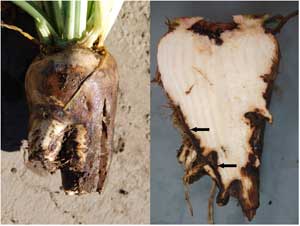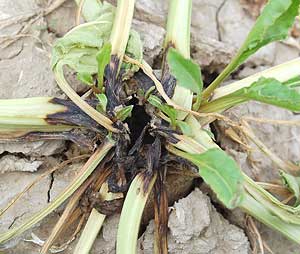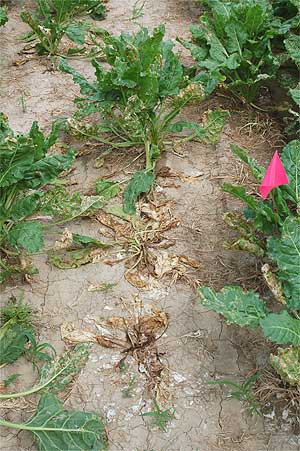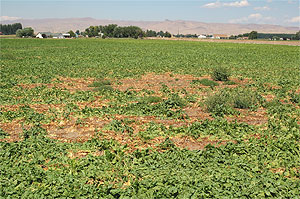USA
October 24, 2012
For sugarbeet growers, Rhizoctonia is a common foe of their sugarbeet crops. Rhizoctonia is a fungus that favors hot temperatures and often overwinters in the soil and on plant tissue before beginning a new season of infection in the spring. Different types of Rhizoctonia called anastomosis groups (AGs) cause a number of diseases like crown and root rot, damping off and foliar blight. Rhizoctonia penetrates the beet through leaf petioles, the crown or the root and can cause up to a 50 percent loss in yield.

Prevention of Rhizoctonia is critical. Management practices begin in the fall with post-harvest field work and careful varietal selection. Oliver T. Neher, University of Idaho extension plant pathologist emphasized the importance of taking time after harvest to minimize inoculum for following years. “It is important to manage plant residues. Plan crop rotation to break up infection cycles and to reduce inoculum buildup. Minimize areas with standing water, hard pans or soil compaction, as they favor the development of Rhizoctonia.”
A proactive approach of planting tolerant varieties is especially important in fields with a chronic history of the disease. Corn and dry beans are alternate host crops for Rhizoctonia, which means that different crops should be considered for rotation with sugarbeets. With all crop rotations, it is important to maintain a clean field as Rhizoctonia has many alternate hosts in weed species, too.

“Growers should use all the tools available to maintain a healthy crop and prevent Rhizoctonia. Plant a tolerant variety and apply a seed treatment. Make a fungicide application and watch irrigation amounts and schedule,” Neher explained.
Choose wisely
Because Rhizoctonia is soil borne and has an effect on many crops, sugarbeets are at risk even before they are planted. Experts recommend planting tolerant seed varieties like Hilleshog® brand varieties to help the crop stand up to the disease.
“I strongly recommend that my growers use tolerant varieties. Planting tolerant or highly tolerant varieties is the most important tool we have. As part of an integrated pest management (IPM) program, the use of a tolerant variety is the first step that should be taken as they are effective in minimizing losses due to Rhizoctonia later in the season,” Neher said.

Pat Mahar, a sugarbeet grower in Cavalier, N.D., meticulously evaluates varieties for their disease performance and has found a Hilleshog brand variety that continues to perform year after year. “Personally, I like the 4094RR variety because of its extensive disease package. The 4094RR has seemed to be healthier than other varieties I have used in past years.”
Because Rhizoctonia is so threatening, Syngenta continues to put resources into the research and development of varieties with Rhizoctonia tolerance. Syngenta Sugarbeet Product Manager Tyler Ring said, “We are committed to keeping this disease at bay and are proud to say that our hybrids are currently number one in Rhizoctonia protection.”
Treat your crop twice
Because the Rhizoctonia trait kicks in later in the season, it’s crucial to protect the crop from the moment the seed hits the soil. Syngenta Agronomic Service Representative Jim Johnson of Michigan urges growers to use a seed treatment when planting.
“Choosing the right seed treatment is essential to preventing Rhizoctonia,” Johnson explained. “Our CruiserMaxx® Sugarbeets insecticide/fungicide seed treatment combines Cruiser® insecticide with Maxim® 4FS, Apron XL® and Dynasty® fungicides. These products work together to improve stand establishment, crop vigor and yield while protecting against Rhizoctonia and other diseases and insects.”

As the crop emerges in spring, scouting becomes essential. Neher cautioned, “If you see a lot of wilted plants in the field with dried up brown and black petioles around them, it is a really good indication that you have Rhizoctonia.”
To positively identify Rhizoctonia, Neher said, “Dig up those beets! It’s not a good idea to go with foliar indicators alone. Take a shovel and dig it up. Then take a knife and cut the beet in half to find the margin of healthy and diseased tissue of the beet.”
Research over the last 10 years from the Michigan State University Sugarbeet Advancement Program and Michigan Sugar Company has shown that Rhizoctonia can be effectively controlled with proper variety selection and optimum timing of an application of Quadris® fungicide. In addition to effective disease control, Quadris also helps crops utilize resources like air, water and nutrients more efficiently.
“As sugarbeet growers, our concern is combating disease because it can take away from yield and it affects quality as well. I have always been a yield guy, so disease management is important to me. We have had the most problems with Rhizoctonia, and have used Quadris regularly to manage it,” Mahar shared. “It is important to focus on a continued research effort to control for Rhizoctonia.”
Neher warned that Rhizoctonia is not going away and growers need to embrace management practices to reduce the risk of infection. “Sadly, we are going to see an increase in this disease,” Neher stated. “Our crop rotation gets closer and closer with fewer non-host crops being planted on the same acres as sugarbeets. I tell my growers and crop consultants that they need to start keeping a log of fields with Rhizoctonia, so that when they come back to plant in that field, they can make a sound decision by using a tolerant variety and seed treatment. As a preventive measure, we also recommend a fungicide application at the 4 to 6 leaf stage to protect against the threat of Rhizoctonia.”
In other words, Neher said, “Be prepared for what is coming because we are not getting rid of Rhizoctonia.”
Important: Always read and follow all bag tag and label instructions before buying or using Syngenta products. The instructions contain important conditions of sale, including limitations of warranty and remedy. Some crop protection products and seed treatments may not be registered for sale or use in all states or counties. Please check with your state or local extension service before buying or using Syngenta products. CruiserMaxx Sugarbeets is a treater-applied combination of separately registered products containing Cruiser 5FS insecticide and three fungicides: Apron XL, Maxim 4FS and Dynasty. Apron XL®, CruiserMaxx®, Cruiser®, Dynasty®, Hilleshog®, Maxim®, Quadris® and the Syngenta logo are registered trademarks of a Syngenta Group Company. Hilleshog is a business unit of Syngenta Seeds, Inc.